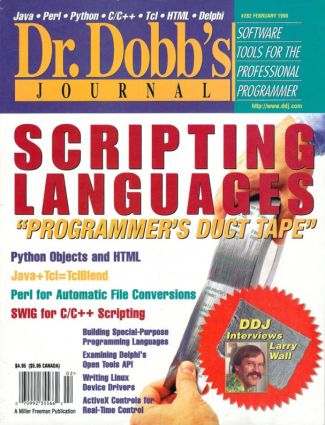
EDITORIAL
[author : Jonathan Erickson] #Edito
TABLE OF CONTENTS
FEATURES
A CONVERSATION WITH LARRY WALL
[author : Eugene Eric Kim]
Perl has been described as everything from "duct tape for the Web" to a "Swiss Army chainsaw." Larry Wall, the creator of the language, takes time to chat with DDJ's Eugene Kim about how and why the language is what it is.
SWIG AND AUTOMATED C/C++ SCRIPTING EXTENSIONS
[author : David Beazley]
SWIG, short for "Simplified Wrapper and Interface Generator," is a freely available tool that lets you generate interfaces to a variety of scripting languages from a common interface description.
TEMPLATE PROCESSING CLASSES FOR PYTHON
[author : Brad Howes]
Brad shows how you can embed Python objects in HTML pages using boilerplate template processing classes. Then Python creator Guido van Rossum adds a note on what's new in the just-released Python 1.5.
TCLBLEND: BLENDING TCL AND JAVA
[author : Scott Stanton]
TclBlend, a scripting language based on Tcl and Java, introduces new Tcl commands that let you directly manipulate Java objects without having to write any Java code. TclBlend also provides access to the Tcl interpreter interfaces through a set of Java classes.
AUTOMATIC FILE CONVERSIONS WITH PERL
[author : Tim Kientzle]
Tim uses Perl to write a smart print filter that recognizes the type of data it is being fed and invokes the appropriate conversion.
A DATA ACQUISITION SYSTEM FOR LINUX
[author : Dhananjay V. Gadre and Sunu Engineer]
Our authors present a general-purpose data-acquisition system for Linux that can be connected to the PC's parallel port to record eight channels of analog voltage.
EMBEDDED SYSTEMS
FLEXIBLE SYSTEM CONTROL AND SPECIAL-PURPOSE LANGUAGES
[author : Russell W. Mello]
Mvcl, the programming language Russell presents here, was designed to do a particular job. It also provides an excellent model for designing reusable software.
INTERNET PROGRAMMING
XML PROGRAMMING IN PYTHON
[author : Sean McGrath]
XML brings to the document world what the database world has had for a long time — interoperability via open systems. Sean shows how you can use Python as a development platform for XML programming.
PROGRAMMER'S TOOLCHEST
THE DELPHI OPEN TOOLS API
[author : Ray Lischner]
Borland's Delphi includes the Open Tools API, a set of classes for extending and customizing the IDE. This means that, in effect, you can use Delphi as a scripting language to extend itself.
AN ACTIVEX CONTROL FOR REAL-TIME COMPUTER CONTROL
[author : Charles H. Huddleston and Douglas A. Troy]
Charles and Douglas present an ActiveX control which enables real-time computer control of external devices and sensors of various kinds in automated control applications. The control is written in C++, while the control system is built using the Lego Dacta Control Lab.
COLUMNS
PROGRAMMING PARADIGMS
[author : Michael Swaine]
When it comes to Apple, who are you going to believe — Steve Jobs, Bill Gates, or Jim Carlton? That's just one question Michael asks as he reads the recently released Apple: The Inside Story of Intrigue, Egomania, and Business Blunders.
C PROGRAMMING
[author : Al Stevens]
With the recent ANSI/ISO stamp of approval, "standard" C++ became a reality. Al takes a look at what this means for the language, focusing on references, assignments, initialization, and the like.
JAVA Q&A
[author : Cliff Berg]
How do you transfer data securely between two locations? Cliff shows you how, using the SSLava security toolkit from Phaos Technology.
ALGORITHM ALLEY
[author : Karl-Dietrich Neubert]
"Classification sorts" are much faster than Quicksort or Heapsort on large amounts of data. But, until now, they were thought to be too memory intensive for widespread use.
UNDOCUMENTED CORNER
[author : George Shepherd and Scot Wingo]
George and Scot continue their examination of Microsoft's Active Template Library, this month focusing on ATL's ActiveX Control architecture.
PROGRAMMER'S BOOKSHELF
[author : Gerald L. Graef]
This month, Gerald examines Expert C Programming: Deep C Secrets, by Peter van der Linden, and Graphical Applications With Tcl and Tk, by Eric F. Johnson.
FORUM
LETTERS
[author : you]
NEWS & VIEWS
[author : the DDJ staff]
OF INTEREST
[author : Eugene Eric Kim]
SWAINE'S FLAMES
[author : Michael Swaine]

